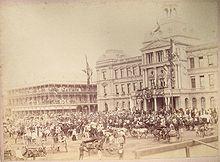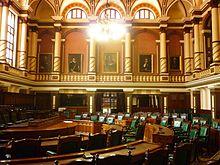The Volksraad (English: "People's Council") was the parliament of the former South African Republic (ZAR), it existed from 1844 to 1877,[1] and from 1881 to 1902[2] in part of what is now South Africa. The body ceased to exist after the British Empire victory in the Second Anglo-Boer War. The Volksraad sat in session in Ou Raadsaal in Church Square, Pretoria.[3]

Initially a unicameral body, the Volksraad was divided into two chambers in 1890 in order to keep Boer control over state matters while still giving Uitlanders (foreigners) — many of whom were temporarily employed in the mining industry — a say in local affairs, in order to fend off British complaints.[4]
From 1890 the Volksraad consisted of two houses of 24 members each.[5] The "Second Volksraad" had suffrage for all white males above 16 years, and had limited legislative powers in the fields of mining, road construction, copyright and certain commercial affairs, all subject to ratification by the "First Volksraad".[6] This was the highest authority in charge of state policy, with preference being given to fully franchised burghers for appointment to government posts.[7]
Volksraad was also the Afrikaans name for the House of Assembly, the principal or sole chamber of the Parliament of South Africa from 1910 to 1994.[8]
References
- ^ Eybers, G. W. (1918). Select constitutional documents illustrating South African history, 1795-1910. George Routledge & Sons, Limited New York; E. P. Button & Co. p. 356, 448-454. Retrieved 16 February 2021.
- ^ Eybers 1917, p. 456, 345.
- ^ Transvaal: The Golden Province, C. van Rensburg Publications, 1992, page 34
- ^ The Afrikaners: Biography of a People, Hermann Giliomee, C. Hurst & Co. Publishers, 2003, page 238
- ^ Eybers 1917, p. 490.
- ^ The Anglo-Boer War: a Chronology, Pieter Gerhardus Cloete, J.P. van der Walt, 2000, page 13
- ^ Judge and be Judged, Adrienne E. Van Blerk, Juta & Company, 1988, page 113
- ^ World Legislatures, John Paxton, Springer, 1974, page 112

